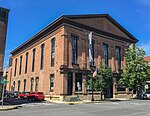Houses at 37–47 North Fifth Street
Houses completed in 1870Houses in Columbia County, New YorkHouses on the National Register of Historic Places in New York (state)Hudson, New YorkItalianate architecture in New York (state) ... and 1 more
National Register of Historic Places in Columbia County, New York

The houses at 37–47 North Fifth Street in Hudson, New York, United States, are a row of six Italianate buildings. They were built around 1870 by Freeman Coons, a local builder. They are an intact example of late 19th-century worker housing in the city, restored at the end of the 20th century by a local community housing group after decades of neglect. In 2003 they were listed on the National Register of Historic Places. They are currently used by a local drug rehabilitation program.
Excerpt from the Wikipedia article Houses at 37–47 North Fifth Street (License: CC BY-SA 3.0, Authors, Images).Houses at 37–47 North Fifth Street
North 5th Street,
Geographical coordinates (GPS) Address Nearby Places Show on map
Geographical coordinates (GPS)
| Latitude | Longitude |
|---|---|
| N 42.250555555556 ° | E -73.785277777778 ° |
Address
North 5th Street 41
12534
New York, United States
Open on Google Maps






